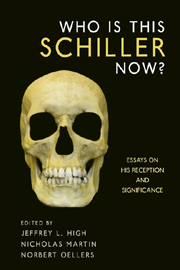Book contents
- Frontmatter
- Contents
- Foreword
- Acknowledgments
- List of Abbreviations
- Introduction: Why Is This Schiller [Still] in the United States?
- Part I Schiller, Drama, and Poetry
- Part II Schiller, Aesthetics, and Philosophy
- Part III Schiller, History, and Politics
- Part IV Schiller Reception — Reception and Schiller
- Part V Schiller Now
- 24 Maria Stuart Adaptations in the Twentieth and Twenty-First Centuries: From “Classical” Parodies to Contemporary Politics
- 25 Whose Schiller Is This? Das Fremde und das Eigene in US Auslandsgermanistik
- 26 Schiller's Political Ideas: Who Cares?
- 27 Where is This Schiller Now?
- Notes on the Contributors
- Index
27 - Where is This Schiller Now?
from Part V - Schiller Now
Published online by Cambridge University Press: 05 February 2013
- Frontmatter
- Contents
- Foreword
- Acknowledgments
- List of Abbreviations
- Introduction: Why Is This Schiller [Still] in the United States?
- Part I Schiller, Drama, and Poetry
- Part II Schiller, Aesthetics, and Philosophy
- Part III Schiller, History, and Politics
- Part IV Schiller Reception — Reception and Schiller
- Part V Schiller Now
- 24 Maria Stuart Adaptations in the Twentieth and Twenty-First Centuries: From “Classical” Parodies to Contemporary Politics
- 25 Whose Schiller Is This? Das Fremde und das Eigene in US Auslandsgermanistik
- 26 Schiller's Political Ideas: Who Cares?
- 27 Where is This Schiller Now?
- Notes on the Contributors
- Index
Summary
It is a gothic tale the protagonist himself probably would have liked. The so-called German Shakespeare was buried three times at three different sites. The mayor of Weimar, Karl Schwabe, and other contemporaries, such as Färber and Schröter, who were both enlisted by Goethe, attempted to locate and identify Schiller's skull and skeleton. However, the questions regarding the authenticity of Schiller's remains persisted. In the nineteenth and twentieth centuries anthropologists and finally DNA-experts tried to solve the mystery once and for all. This article describes the various endeavors, including the developments during the Second World War in Weimar and later in the former GDR, and assesses the most recent attempts to locate Schiller's remains.
WE HAD BEEN LED TO BELIEVE that the skeletal remains of the two most influential German writers lie side by side in Weimar; Goethe the erstwhile attorney from Frankfurt on the Main, the ennobled author, and genuine privy council, who eventually became Minister of State and Excellency; and Schiller, the erstwhile physician from Stuttgart, Associate Professor of Philosophy, Court Council, and finally likewise ennobled author. The coffins rest slightly elevated, each adorned with bay wreaths befitting the revered Dioscuri, and practically identical in form and color; Schiller on the right, Goethe on the left, the arrangement not indicative of deeper meaning, but merely dependent on the perspective of the individual onlooker. As to the actual contents of the sarcophagi, however, questions lingered.
- Type
- Chapter
- Information
- Who Is This Schiller Now?Essays on his Reception and Significance, pp. 451 - 466Publisher: Boydell & BrewerPrint publication year: 2011



